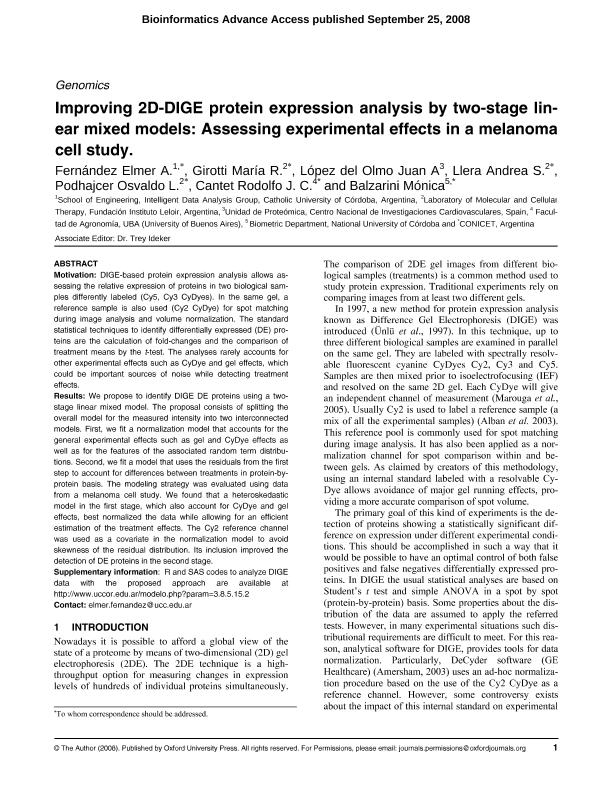Mostrar el registro sencillo del ítem
dc.contributor.author
Fernandez, Elmer Andres

dc.contributor.author
Girotti, Maria Romina

dc.contributor.author
López del Olmo, Juan A.
dc.contributor.author
Llera, Andrea Sabina

dc.contributor.author
Podhajcer, Osvaldo Luis

dc.contributor.author
Cantet, Rodolfo Juan Carlos

dc.contributor.author
Balzarini, Monica Graciela

dc.date.available
2018-02-22T14:56:28Z
dc.date.issued
2008-12
dc.identifier.citation
Fernandez, Elmer Andres; Girotti, Maria Romina; López del Olmo, Juan A. ; Llera, Andrea Sabina; Podhajcer, Osvaldo Luis; et al.; Improving 2D-DIGE protein expression analysis by two-stage linear mixed models: Assessing experimental effects in a melanoma cell study; Oxford University Press; Bioinformatics (Oxford, England); 24; 23; 12-2008; 2706-2712
dc.identifier.issn
1367-4803
dc.identifier.uri
http://hdl.handle.net/11336/36959
dc.description.abstract
Motivation: Difference in-gel electrophoresis (DIGE)-based protein expression analysis allows assessing the relative expression of proteins in two biological samples differently labeled (Cy5, Cy3 CyDyes). In the same gel, a reference sample is also used (Cy2 CyDye) for spot matching during image analysis and volume normalization. The standard statistical techniques to identify differentially expressed (DE) proteins are the calculation of fold-changes and the comparison of treatment means by the t-test. The analyses rarely accounts for other experimental effects, such as CyDye and gel effects, which could be important sources of noise while detecting treatment effects. Results: We propose to identify DIGEDE proteins using a two-stage linear mixed model. The proposal consists of splitting the overall model for the measured intensity into two interconnected models. First, we fit a normalization model that accounts for the general experimental effects, such as gel and CyDye effects as well as for the features of the associated random term distributions. Second, we fit a model that uses the residuals from the first step to account for differences between treatments in protein-by-protein basis. The modeling strategy was evaluated using data from a melanoma cell study. We found that a heteroskedastic model in the first stage, which also account for CyDye and gel effects, best normalized the data, while allowing for an efficient estimation of the treatment effects. The Cy2 reference channel was used as a covariate in the normalization model to avoid skewness of the residual distribution. Its inclusion improved the detection of DE proteins in the second stage.
dc.format
application/pdf
dc.language.iso
eng
dc.publisher
Oxford University Press

dc.rights
info:eu-repo/semantics/openAccess
dc.rights.uri
https://creativecommons.org/licenses/by-nc-sa/2.5/ar/
dc.subject
Melanoma
dc.subject
2d Dige
dc.subject
Bioinformatics
dc.subject
Protein Expression
dc.subject.classification
Otras Ciencias Biológicas

dc.subject.classification
Ciencias Biológicas

dc.subject.classification
CIENCIAS NATURALES Y EXACTAS

dc.title
Improving 2D-DIGE protein expression analysis by two-stage linear mixed models: Assessing experimental effects in a melanoma cell study
dc.type
info:eu-repo/semantics/article
dc.type
info:ar-repo/semantics/artículo
dc.type
info:eu-repo/semantics/publishedVersion
dc.date.updated
2018-01-12T19:24:56Z
dc.journal.volume
24
dc.journal.number
23
dc.journal.pagination
2706-2712
dc.journal.pais
Reino Unido

dc.journal.ciudad
Oxford
dc.description.fil
Fil: Fernandez, Elmer Andres. Universidad Católica de Córdoba; Argentina. Consejo Nacional de Investigaciones Científicas y Técnicas; Argentina
dc.description.fil
Fil: Girotti, Maria Romina. Consejo Nacional de Investigaciones Científicas y Técnicas. Oficina de Coordinación Administrativa Parque Centenario. Instituto de Investigaciones Bioquímicas de Buenos Aires. Fundación Instituto Leloir. Instituto de Investigaciones Bioquímicas de Buenos Aires; Argentina
dc.description.fil
Fil: López del Olmo, Juan A.. Fundación Centro Nacional de Investigaciones Cardiovasculares; España
dc.description.fil
Fil: Llera, Andrea Sabina. Consejo Nacional de Investigaciones Científicas y Técnicas. Oficina de Coordinación Administrativa Parque Centenario. Instituto de Investigaciones Bioquímicas de Buenos Aires. Fundación Instituto Leloir. Instituto de Investigaciones Bioquímicas de Buenos Aires; Argentina
dc.description.fil
Fil: Podhajcer, Osvaldo Luis. Consejo Nacional de Investigaciones Científicas y Técnicas. Oficina de Coordinación Administrativa Parque Centenario. Instituto de Investigaciones Bioquímicas de Buenos Aires. Fundación Instituto Leloir. Instituto de Investigaciones Bioquímicas de Buenos Aires; Argentina
dc.description.fil
Fil: Cantet, Rodolfo Juan Carlos. Universidad de Buenos Aires; Argentina. Consejo Nacional de Investigaciones Científicas y Técnicas; Argentina
dc.description.fil
Fil: Balzarini, Monica Graciela. Universidad Nacional de Córdoba; Argentina. Consejo Nacional de Investigaciones Científicas y Técnicas; Argentina
dc.journal.title
Bioinformatics (Oxford, England)

dc.relation.alternativeid
info:eu-repo/semantics/altIdentifier/url/https://academic.oup.com/bioinformatics/article/24/23/2706/179880
dc.relation.alternativeid
info:eu-repo/semantics/altIdentifier/doi/http://dx.doi.org/10.1093/bioinformatics/btn508
Archivos asociados
